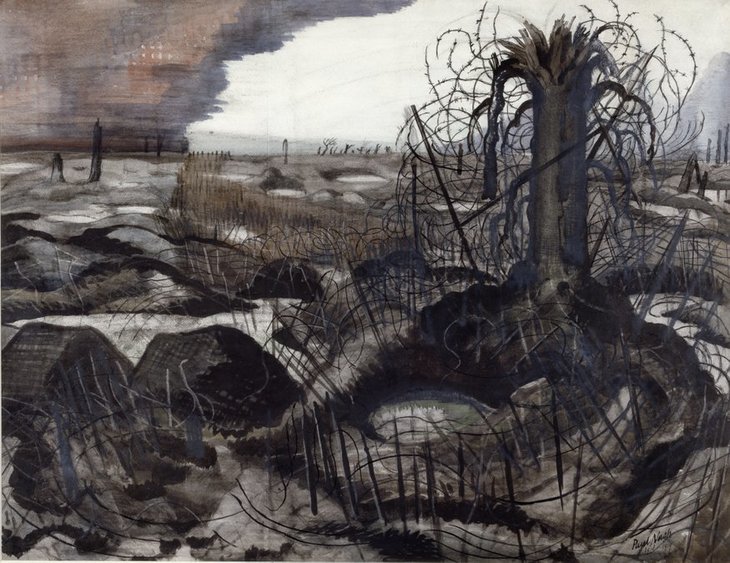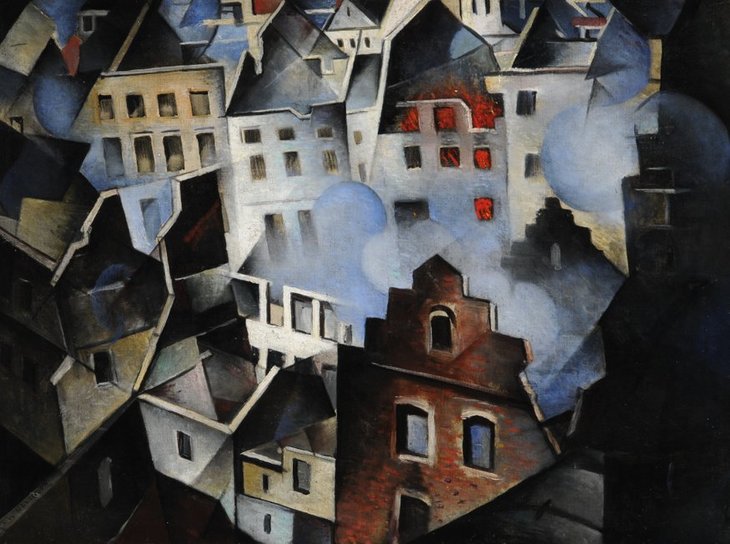War Is Horrific. War Is Futile. War Is Hell. That's The Message At Tate Britain
Looks like this article is a bit old. Be aware that information may have changed since it was published.

A landscape that was once green is now blackened, pocked with holes made from shells. A tree in the foreground has been splintered so it's just a blackened husk, a washed out trench looks apocalyptic and only a lone upturned helmet signifies there was ever any life here. These paintings don't contain any bodies or even a drop of blood, yet they convey the same message. War is horrific. War is futile. War is hell. Abandon all hope, ye who enter here.
This is the gut punch we experience in our first five minutes of entering Tate Britain's new exhibition on the first world war, and the art created in its aftermath.

Two soldiers lie face down in the mud among the barbed wire, their rifles at their side. CRW Nevinson's painting titled Paths of Glory is one of the strongest anti-war works we've ever seen, and even though we've seen it before, the impact isn't lessened. We're not celebrating war as something heroic here, we're seeing it for what it is — an instrument of mass death.
A nearby soldier's body has been throw in the air and impaled on a tree stump and one corpse lies next to a water-filled shell crater, as if he managed to crawl out the hole with his last efforts. What these painters from the battlefront are showing us is that war cares not for human dignity.

Two french soldiers sit in a trench, their faces looking like they are made of granite. It shows us both their stoicism and their dehumanisation, as if the hardships are slowly turning them to stone. A bronze relief shows a sentry standing guard, hidden beneath corpses strung over barbed wire. The smell alone must have been overpowering, and yet he continues to perform his duty.
It's not just the human costs of war in this show, as photographs show us the damage to Reims Cathedral and a film of Ypres post-battle shows how much damage the land has sustained.

The survivors didn't have it easy with many disfigured, as seen in the illustrations of Henry Tonks, including one horrific example of a man with his entire lower jaw missing.
The first two thirds of this exhibition is an challenge to get through, so shocking are the images we're seeing. Every time we get our breath back, another horrific painting knocks the wind back out of us again.

After this, the exhibition takes us into the light — quite literally, by changing the colour of the walls — to painting after the war. It's now all sickeningly sweet paintings of sheep in fields and cherubic youths. Some of these paintings are frankly awful, but it's interesting to see how artists were in denial and trying to focus on happier times once the war was behind them.
It's not all post-war bliss though, as we see women resorting to prostitution as economic hardship sets in, and a well-dressed bureaucrat waltzes by ignoring the struggling war veteran behind him.

The final third of this show has some strong works but it can't match the first six rooms for their sheer intensity. The first world war may have ended a century ago, but these paintings still serve to make this exhibition a reminder of the horrors of war; we think world leaders should visit this show to discourage them from ever waging war again — better add this to Trump's itinerary for when he visits the UK.
Aftermath: Art in the wake of World War One is on at Tate Britain until 23 September 2018. Tickets are £16-18 for adults.
Last Updated 05 June 2018




